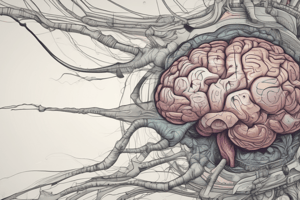Podcast
Questions and Answers
How do animals determine where a sound came from?
How do animals determine where a sound came from?
Animals determine where a sound came from by comparing the time of arrival of the sound at each ear.
In which spatial coordinate system should stimuli be localized?
In which spatial coordinate system should stimuli be localized?
Stimuli should be localized in egocentric spatial coordinate system.
How do animals orient toward an interesting stimulus?
How do animals orient toward an interesting stimulus?
Animals orient toward an interesting stimulus by turning their head or body towards it.
How do animals navigate through space?
How do animals navigate through space?
How can animals determine where a sound came from?
How can animals determine where a sound came from?
What is the role of the frontal eye fields in triggering saccadic eye movements?
What is the role of the frontal eye fields in triggering saccadic eye movements?
What happens when the superior colliculus is silenced with lidocaine?
What happens when the superior colliculus is silenced with lidocaine?
How are saccadic head and eye movements coordinated?
How are saccadic head and eye movements coordinated?
Which brain region is involved in targeted hand movements?
Which brain region is involved in targeted hand movements?
What is the consequence of lesions in the posterior parietal cortex?
What is the consequence of lesions in the posterior parietal cortex?
How are head position and gaze direction graphed in eye movement control?
How are head position and gaze direction graphed in eye movement control?
What are the different types of saccades, and how are they commanded?
What are the different types of saccades, and how are they commanded?
How do eye muscles contribute to rotating the eyeball, and what is the energy requirement for looking straight ahead?
How do eye muscles contribute to rotating the eyeball, and what is the energy requirement for looking straight ahead?
What is the significance of the superior colliculus in saccade control?
What is the significance of the superior colliculus in saccade control?
How do auditory spatial receptive fields behave as the eyes move?
How do auditory spatial receptive fields behave as the eyes move?
What are the possible coordinate frames in which neurons encode spatial information?
What are the possible coordinate frames in which neurons encode spatial information?
What is the mechanism by which animals orient toward an interesting stimulus?
What is the mechanism by which animals orient toward an interesting stimulus?
Flashcards are hidden until you start studying



